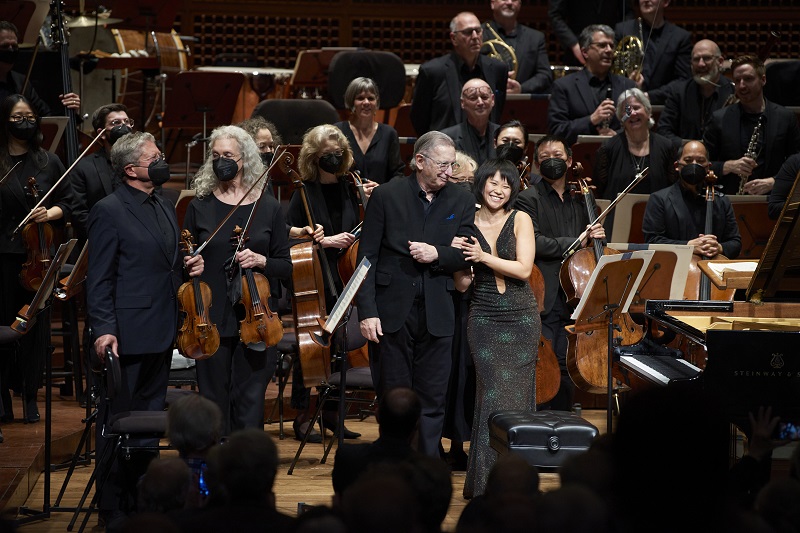 United States Liszt, Mahler: Yuja Wang (piano), San Francisco Symphony / Michael Tilson Thomas (conductor). Davies Symphony Hall, San Francisco, 27.1.2022. (HS)
United States Liszt, Mahler: Yuja Wang (piano), San Francisco Symphony / Michael Tilson Thomas (conductor). Davies Symphony Hall, San Francisco, 27.1.2022. (HS)

Liszt – Piano Concerto No.1 in E-flat major
Mahler – Symphony No.1 in D major
It takes something extraordinary to overshadow a Mahler symphony in an orchestral program, especially with Michael Tilson Thomas on the podium and the San Francisco Symphony. They have been making magic with Mahler’s music for this conductor’s long tenure as music director, and now as Conductor Laureate.
Liszt’s flashy, brash Piano Concerto No.1 can hardly match Mahler’s joyride on depth, but in the hands (literally) of Yuja Wang it sprang to life with a swagger and surprising subtlety. Both pianist and conductor have a long performance history together with this orchestra, and they demonstrated an uncanny ability to get on the same page and, more importantly, execute.
The results were thrilling from the very first measures. Interjections of each other’s statements of the main theme sprang from the same source with perfect timing and balance. Wang’s attention to phrasing and dynamics, her touch on the keyboard yielding inflections of tone, brought the familiar strains to life with freshness and intelligence. The orchestra’s volume, sense of rhythm and articulation framed the music and soloist with striking precision.
Wang took the nearly full audience on a breathtaking journey through Liszt’s catalog of pianistic showiness, tossing off massive chords, fast-moving parallel octaves and sprinkles of feathery ornamental runs with such ease that they could come off as fundamental elements. The effect was bold and many-faceted, more than mere athletic showoffiness.
Whether it was the joy of making music again with Tilson Thomas, who is back conducting after major surgery last year, or their long history as musicians and friends, Wang hung on Tilson Thomas’s arm like the old friends they are when they took their bows. At one point, the conductor duplicated Wang’s signature deep bows – smiling broadly. Needless to say, the audience’s reaction was a sustained roar, demanding three curtain calls but not getting an encore.
Although the concerto lists four movements (or at least tempo changes), it is played without pauses. In its episodic format and a through-line of a single tune, it foreshadowed the Mahler Symphony No.1 that followed after intermission. The concerto’s 20-minute running time (at the brisk tempos these musicians took) is about the same as the final movement of the Mahler.
The conductor and orchestra played this symphony almost exactly five years ago. They recorded it earlier for a much-lauded CD set, and it was the focus of Tilson Thomas’s hour-long documentary on Mahler, part of the symphony’s own Keeping Score series of videos. In other words, they know it inside out.
The performance had plenty of energy and a marvelous sense of momentum. Tempos pushed the motion forward, and the big moments in the finale had real majesty, even if previous performances, lingering over every detail, created more of a feeling of discovery at each turn.
All the soloists within the orchestra contributed fine moments in their time in the spotlight. Presiding over an array of timpani, Edward Stephan punctuated every phrase with just the right combination of bravado and accuracy. The solos bouncing around the orchestra in parts of the third movement made a joy of Mahler’s replica of klezmer music, especially those by principal clarinet Carey Bell and concertmaster Alexander Barantschik.
Highest marks go to the brass. In the opening, the trumpet trio’s offstage fanfares added to an atmosphere already established by the clarinet’s cuckoos and a plush texture from the strings. The entire section grabbed onto the rapid-fire fanfares with bracing power. Principal horn Robert Ward went from lyrical elegance in the third movement to leading the seven members of his section in a broad and expressive contribution to the finale.
Harvey Steiman
